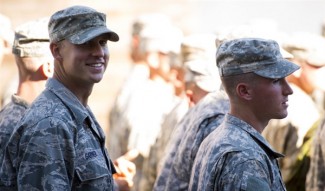 PHOTO: Air Force 1st Lt. Casey Garner, left, before graduation from U.S. Army Ranger School at Fort Benning, Ga., Oct. 17, 2014. U.S. Air Force photo by Airman 1st Class Ryan CallaghanFORT BENNING, Ga. – On average, more than 4,000 soldiers go through the U.S. Army Ranger School here each year. Just more than 300 Air Force airmen have completed the course since its inception in 1950. Of these 300 Ranger-qualified airmen, 1st Lt. Casey Garner is the first of his kind. Garner, an air liaison officer with the 7th Air Support Operations Squadron at Fort Bliss, Texas, became the first ALO to graduate from Ranger School, completing the rigorous 61-day course.
PHOTO: Air Force 1st Lt. Casey Garner, left, before graduation from U.S. Army Ranger School at Fort Benning, Ga., Oct. 17, 2014. U.S. Air Force photo by Airman 1st Class Ryan CallaghanFORT BENNING, Ga. – On average, more than 4,000 soldiers go through the U.S. Army Ranger School here each year. Just more than 300 Air Force airmen have completed the course since its inception in 1950. Of these 300 Ranger-qualified airmen, 1st Lt. Casey Garner is the first of his kind. Garner, an air liaison officer with the 7th Air Support Operations Squadron at Fort Bliss, Texas, became the first ALO to graduate from Ranger School, completing the rigorous 61-day course.
Wearing the Ranger tab on his shoulder will give Garner an unprecedented advantage among ALOs while working to supply air support to the Army units he will be attached to, he said.
Instant credibility "As an ALO, you work around a lot of Army officers -- infantry, particularly," Garner said. "If they see that Ranger tab on your shoulder, you have instant credibility. That allows me to take better care of my [joint terminal attack controllers], because it incorporates me into the planning more. It just [earns] me that respect amongst the Army [when] they see that I'm willing to go and put myself through that with my Army brothers." Garner said he knew it would be a challenge, given the course's 40 to 50 percent completion rate, but his inclination for leadership was a driving force that helped him through the adversities and challenges. "I had heard about the challenges of the school," Garner said. "I knew it would mentally and physically test me to [my] ultimate limit. I wanted to prove to myself, and prove to the men that I was going to lead, that I could acquire that leadership -- [that] I could lead them through the most trying times."
Garner said being the lone airman in a sea of soldiers was an obstacle at first. "The most challenging part was learning the operation order process for how you brief your squadron on the upcoming mission,” he said. “It's a very specific [process]. Infantry officers are taught this at a very early stage, and as an Air Force officer, I was thrust into that role. I had to learn on the run. "My squadron really helped me out with the skill sets that I didn't know at that time," Garner continued. "It was a really neat experience bringing that other-branch mentality into it. I was known as 'Air Force,' but I made some really good, lifelong friends."
Emphasis on developing leadership abilities under stress The course averages 19 hours of training per day, seven days a week. It creates students proficient in tactics and techniques for operations in wooded, mountainous, jungle and swamp environments. In addition to the strenuous training, said Army Lt. Col. Thomas Sager, the 4th Ranger Training Battalion commander, the emphasis is developing leadership abilities under conditions of mental and emotional stress. "These men have all learned to be to be technically and tactically sufficient at patrolling, small unit and infantry tactics," Sager said. "Most importantly, they learned about themselves. They learned about their strengths and weaknesses when they were tired, wet, cold and hungry. They will leave here feeling confident in their ability to lead soldiers in the most difficult and arduous conditions."
The endeavor was worth it, Garner said. "It feels wonderful," he added. "It feels great to finally be done and to have made it through on the first go. It changes your life once you get the tab. You're a different man, a different person. It's worth all the pain, everything you put your body through is worth it."
Written Oct. 27, 2014 By: Air Force Airman 1st Class Ryan Callaghan 23rd Wing
Republished and redistributed by permission of DoD.


